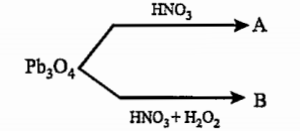Complete Solutions to EXERCISE of chapter MOCK TEST 7 of Class 12 book with complete answers and questions
| Class 12 | CHEMISTRY |
| Chapter | MOCK TEST 7 |
| KVPY PREVIOUS YEAR | EXERCISE |
| Number Of Questions | 26 |
| Academic Year | 2023-24 |
One mole of calciium phosphide on reaction with excess water gives
02:17View SolutionCoagulation value of the electrolytes `AlCl_(3)` and NaCl for `As_(2)S_(3)` sol are 0.093 and 52 respectively. How many times `AlCl_(3)` has greater coagulating power than NaCl?
03:16View SolutionThe enthalpy of neutralisation of a weak acid in 1 M solution with a strong base is `-56.1` kJ `mol^(-1)`/ If the enthalpy of ionization of the acid is 1.5 kJ `mol^(-1)` and enthalpy of neutralization of the strong acid with a strong base is `-57.3` kJ `"equiv"^(-1)`, what is the % ionization of the weak acid in molar solution (assume the acid to be monobasic)?
02:21View SolutionA metal gives two chlorides 'A' and 'B'.'A' gives black precipitate with `NH_(4)OH` and 'B' gives white ppt. With KI 'B' gives a red precipitate soluble in excess of KI.'A' and 'B' are respectively `:`
08:29View SolutionAn alkyl halide with molecular formula `C_6H_(13)Br` on dehyrohalogenation gives two isomeric alkenes X and Y with molecular formula `C_6H_(12)`. On reductive ozonolysis X and Y gives four compounds `CH_3COCH_3`, `CH_3CH_2CHO` and `(CH_3)_2CHCHO`. The alkyl halide is
05:37View SolutionThe correct order of `o^(-)` bond lengths in `ClO^(-), ClO_(2)^(-), ClO_(3)^(-) and ClO_(4)^(-)` is
03:17View SolutionThe compound `P, Q and S`

were separately subjected to nitration using `HNO_(3)//H_(2)SO_(4)`mixture. The major product formed in each case respectively is05:50View SolutionWhich fo the following statements are correct concerning redox propreties ?
(i) The reducing power of hydrogen halides increases from hydrogen chloride to hydrogen iodide.
(ii) The oxidizing power of halogens decreases from chlorine to iodine.
(iii) A metal M for which `E^(Ɵ)` for the half-reaction
`M^(n+) +n e^(-) hArr M`
is very negative will be a good reducing agent.04:05View SolutionAn 1% solution of `KCI(I),NaCI(II), BaCI_(2)(III)` and urea (IV), have their osmotic pressure at the same temperature in the ascending order (molar masses of `NaCI, KCI, BaCI_(2)` and urea are respectively `58.5, 74.5, 208.4, 60 g mol^(-1)` Assume 100% ionization of the electrolytes at this temperature
03:09View SolutionGiven
(a) `n=5,m_(i)=+1` (b) `n=2,l=1,m_(i)=-1,m_(s)=-1//2`
The maximum number of electron(s) in an atom that can have the quanturm numbers as given in (a) and (b) are respectively:03:08View SolutionA decapeptide (Mol. Wt. 769) on complete hydrolysis gives glycine (Mol. Wt. 75), alanine and phenylalanine.
Glycine contributes `47.0 %` to the total weight of the hydrolysed products. The number of glycine units. Present in the decapeptide is.03:10View SolutionAmongst `LiCl, RbCl, BeCl_2` and `MgCl_2,` the compounds whith the greatrest and the least ionic character respecitely are :
03:46View SolutionA monotomic ideal gas undergoes a process in which the ratio of p to V at any instant is constant and equals to 1. what is the molar heat capacity of the gas?
02:28View SolutionWhich one of the following pairs of substances on reaction will not not evolve `H_2` gas?
01:20View SolutionThe elecron affinity of chlorine is `3. 7 eV`. How much energy in kcal is released when `2g` chlorine is completely converted to `cl^-` ion in a gaseous state ?
`(1 eV = 23. 06 kcal "mol"^(-10))`.02:39View SolutionA `to` B+ C is a first order reaction

Reagent reacts with all A, B and C and have 'n' factors in the ratio of 1 : 2 : 3 with the reagent. Find k.03:04View SolutionAmong the given compound choose the two that yeild same carbocation on ionization
 02:35View Solution
02:35View SolutionCalculate the pH at the equivalence point when a solution of 0.01 M `CH_3COOH` is titrated with a solution of 0.01 M NaOH. `pK_a` of `CH_3COOH` is 4.74.
07:56View SolutionA salt which gives `CO_2` with hot `H_2SO_4` and also decolourises acidified `KMnO_4` on warming is
03:28View SolutionFor the octahedral complexes of `Fe^(3+)` in `SCN^(-)` (thiocyanato -S) and in `CN^(-)` ligand environments, the difference between the spin only magnetic moments in Bohr magnetons (when approximated to the nearest integer) is [atomic number of `Fe = 26` ]
03:06View SolutionIn the following reactions, the Pb compounds A and B are respectively.
 03:30View Solution
03:30View SolutionConsider the cell `Ag|AgBr(s)Br^(-)||AgCl(s)Cl^(-)|Ag` at 298 K the solubility product of AgCl and AgBr are `1xx10^(-10)` and `5xx10^(-13)` respectively. What should be the ratio of concentration of `Br^(-)` and `Cl^(-)` by which emf of the cell becomes zero?
09:02View SolutionThe kinetic energy of an electron in the second Bohr orbit of a hydrogen atom is [`a_0` is Bohr radius] :
03:30View SolutionConsider the following list of regents: Acidified `K_(2)Cr_(2)O_(7)`, alkaline `KMnO_(4)`, `CuSO_(4)`, `H_(2)O_(2)`, `CI_(2)`, `O_(3)`, `HNO_(3)`, and `Na_(2)S_(2)O_(3)`. The total number of reagents that can oxidis aqueous `I^(Theta)` ion `I_(2)` is
06:02View SolutionThe degree of dissociation is `0.4` at `400 K` and `1.0` atm for the gaseous reaction
`PCl_(5) hArr PCl_(3)+Cl_(2)`
assuming ideal behaviour of all gases, calculate the density of equilibrium mixture at `400 K` and `1.0` atm (relative atomic mass of P is `31.0` and of Cl is `35.5`).03:20View SolutionGeometrical shapes of the complex formed by the reaction of `Ni^(2+)` with `Cl^(Θ),CN^(Θ)` and `H_(2)O` are :
05:03View Solution
EXERCISE questions and complete solutions for chapter MOCK TEST 7 of KVPY PREVIOUS YEAR of Class 12
